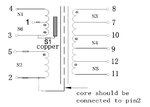T
treez
Guest
Hello,
Please could you advise why there are two strangely connected shield windings in our Offline Flyback transformer?
There are two shield windings in the transformer as shown in the transformer diagram attached to this post.
This Flyback SMPS is 67W and VAC input is 100VAC to 265VAC.
The output charges up to 340V, so to make the voltage reflected to the primary less, the designer used three separate secondaries (N3, N4 and N5) and “stacked” their outputs. (as shown in the schematic attached).
It actually appears that the two shield windings are connected in a manner which we would not want. I thought that shield windings were just supposed to connect to a single place, eg primary or secondary ground or power?
What is the purpose of doing the shield windings as in the attached transformer diagram?
(LTspice simulation also attached though not needed)
Please could you advise why there are two strangely connected shield windings in our Offline Flyback transformer?
There are two shield windings in the transformer as shown in the transformer diagram attached to this post.
This Flyback SMPS is 67W and VAC input is 100VAC to 265VAC.
The output charges up to 340V, so to make the voltage reflected to the primary less, the designer used three separate secondaries (N3, N4 and N5) and “stacked” their outputs. (as shown in the schematic attached).
It actually appears that the two shield windings are connected in a manner which we would not want. I thought that shield windings were just supposed to connect to a single place, eg primary or secondary ground or power?
What is the purpose of doing the shield windings as in the attached transformer diagram?
(LTspice simulation also attached though not needed)
Attachments
Last edited by a moderator:
